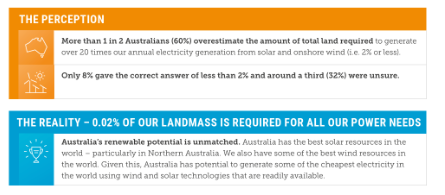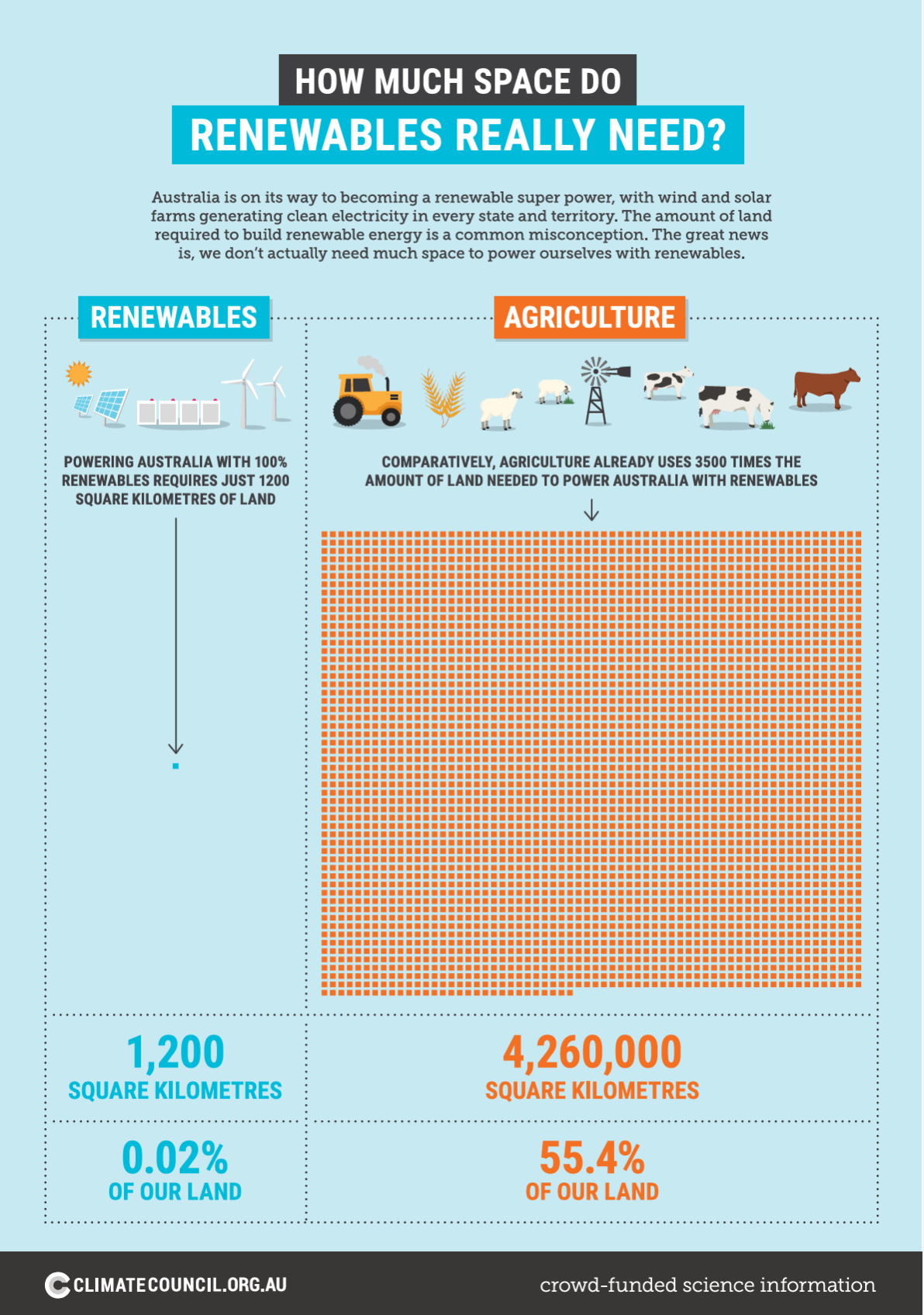
FACT SHEET: renewable power and land use
Climate Media Centre
The best and latest scientific evidence shows that the biggest threat to the environment is climate change. The CSIRO’s GenCost analysis shows the fastest and cheapest way to secure Australia’s energy supply is to switch to renewable power such as wind and solar.
This new infrastructure needs to be planned and developed in consultation with communities and in a way that has minimal impacts on nature and the environment. When done well, communities can realise benefits beyond reducing emissions and having access to clean energy.
Evidence-based resources:
-
Land use for renewables power infrastructure - 0.02% of our landmass is required for all our power needs (Source: Climate Council report Electric Shock)
Click here to download the infographic
-
Land clearing for coal-fired power plants has destroyed koala habitat. During the last term of parliament, the Albanese Government approved plans allowing more than 1,790 hectares of koala habitat to be cleared for four coal mines. 10,614 hectares of habitat remains on the chopping block, and would be cleared as part of 24 proposed new and expanding coal mines - the area of habitat is equivalent to 8,845 Suncorp stadiums. (Source: Koalas not Coal report analysis coal mine approvals)
-
There is majority support for renewable power in regional communities and the broader Australian population (Source: Farmers for Climate Action polling; CSIRO survey shows 80% of Australians are willing to live near renewable infrastructure).
-
Farmers, including the National Farmers Federation President David Jochinke, are benefitting from hosting renewable energy on their land where farming and clean energy generation happily co-exist. Renewable energy projects give farmers an opportunity to diversify their incomes, which is becoming increasingly important as climate change fuels more frequent and intense extreme weather events.
The Climate Media Centre can connect you to farmers who host renewable power generation projects on their land.
-
Communities around Australia are seeing wide-ranging benefits from switching to renewable energy including:
-
Dandenong Cricket Club’s solar panels save the club $10,000 per year which they are diverting into supporting the women’s game (Source: Herald Sun, Cricket for Climate)
-
Haystacks Solar Garden is the first solar garden in Australia – leading the way to show how we can unlock the benefits of solar for people renting and living in apartments with community-owned renewables.
-
Bomen Solar Farm’s ‘Women in Solar’ program shows how the industry can combat traditional barriers to employment in the energy sector, by directly helping women gain new skills, experience and qualifications for future employment in energy.
-
South Australia’s Virtual Power Plant is leading the way to show how governments can help lower power bills for citizens who are doing it tough (in this case: those living in social housing), while also helping to provide more clean power to the community and strengthening the energy grid.
-
The New England Solar Farm demonstrates how renewables can happily coexist with farming. As one of Australia’s newest and largest solar farms, it’s providing ideal grazing conditions for around 6,500 sheep and lambs.
-
The Marlinja Microgrid is leading the way for other projects to help First Nations communities take control of their power. It is the first First Nations community-owned and grid connected renewable energy project in Australia, and will enable First Nations pre-paid meter customers to benefit directly from their own solar investment; working in a similar way to the benefits enjoyed by households with rooftop solar.
If you would like more information on land use, support for renewable energy or case studies and expert spokespeople, please contact the Climate Media Centre team.
Director
Danielle Veldre +408972997 [email protected]
Senior Media Advisor
Jemimah Taylor +478 924 425 [email protected]
Senior Media Advisor
Sean Kennedy +447 121 378 [email protected]
Media Advisor
Gabrielle Platt +493 224 307 [email protected]

